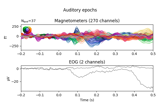mne.preprocessing.regress_artifact#
- mne.preprocessing.regress_artifact(inst, picks=None, picks_artifact='eog', betas=None, copy=True, verbose=None)[source]#
Remove artifacts using regression based on reference channels.
- Parameters:
- instinstance of
Epochs|Raw The instance to process.
- picks
str|list|slice|None Channels to include. Slices and lists of integers will be interpreted as channel indices. In lists, channel type strings (e.g.,
['meg', 'eeg']) will pick channels of those types, channel name strings (e.g.,['MEG0111', 'MEG2623']will pick the given channels. Can also be the string values “all” to pick all channels, or “data” to pick data channels. None (default) will pick good data channels. Note that channels ininfo['bads']will be included if their names or indices are explicitly provided.- picks_artifactarray-like |
str Channel picks to use as predictor/explanatory variables capturing the artifact of interest (default is “eog”).
- betas
ndarray, shape (n_picks, n_picks_ref) |None The regression coefficients to use. If None (default), they will be estimated from the data.
- copybool
If True (default), copy the instance before modifying it.
- verbosebool |
str|int|None Control verbosity of the logging output. If
None, use the default verbosity level. See the logging documentation andmne.verbose()for details. Should only be passed as a keyword argument.
- instinstance of
- Returns:
Notes
To implement the method outlined in [1], remove the evoked response from epochs before estimating the regression coefficients, then apply those regression coefficients to the original data in two calls like (here for a single-condition
epochsonly):>>> epochs_no_ave = epochs.copy().subtract_evoked() >>> _, betas = mne.preprocessing.regress(epochs_no_ave) >>> epochs_clean, _ = mne.preprocessing.regress(epochs, betas=betas)
References
